Stakeholders are people or organizations that are internal or external to the project who have a vested interest in its success. That interest can positively or negatively impact the project management process. Therefore, it’s crucial to know your project stakeholders.
More than just being able to identify who the stakeholders are in the project, you need to manage them. It’s a big task. How do you know who needs what when communicating with them during the project? That is the beginning of stakeholder analysis, and it starts with stakeholder mapping.
What Is Stakeholder Mapping?
Stakeholder mapping is a visual process. It charts each stakeholder for your project, product or anything with stakeholders to show who can influence the work you’ll be doing. Stakeholders can be your client, project owner or even end-users. They are anyone who has a vested interest in the project. Using a stakeholder map allows a project manager to understand how each stakeholder is involved with the project and, therefore, how to respond to them. For example, some stakeholders will need to be updated on the progress of the project regularly. These stakeholders are more likely clients, owners or top executives at the organization you’re working for.
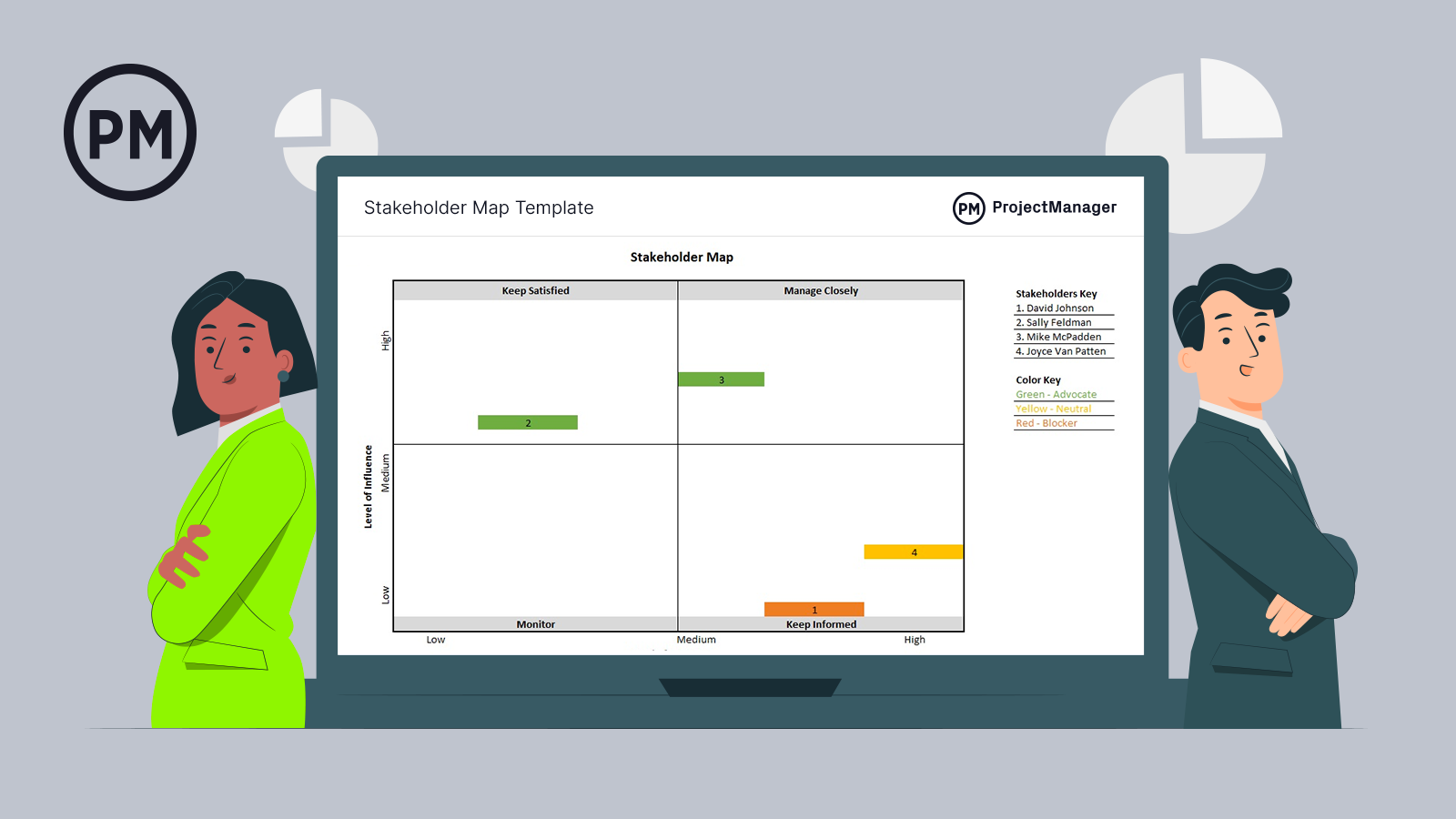
Get your free
Stakeholder Map Template
Use this free Stakeholder Map Template to manage your projects better.
Get the template
But that is only one type of stakeholder that you’ll map. Other stakeholders can be suppliers, investors, retailers, developers, designers, et al. In general, stakeholders can be divided into two groups: internal and external. Internal stakeholders are participating in the project, while external stakeholders are impacted by it.
What Is a Stakeholder Map?
A stakeholder map is a visual, four-quadrant influence-interest matrix used in project management to identify stakeholders and categorize them in terms of their influence and interest in the project. A stakeholder map might also be referred to as a stakeholder matrix, power interest grid or stakeholder chart.
The y axis determines the level of interest, from highest on the top to lowest on the bottom—meaning how much the stakeholders are impacted by the outcome of the project. The x-axis of the power interest grid measures the stakeholder’s level of influence, or how much the stakeholder can impact the project, from low (left side) to high (right side). Stakeholders are then plotted on this map depending on how they fall on those two metrics.
A stakeholder map is the first step toward stakeholder management in that it defines the stakeholder’s relationship to the project. It will inform almost every decision a project manager makes regarding their stakeholders, including the frequency of their meetings and how much information they are given about the project.
Stakeholder Map Template
To give you an example and the opportunity to create your own stakeholder map, download our stakeholder map template. It provides the outline and all you have to do is add the details. Our stakeholder map template is shown below:
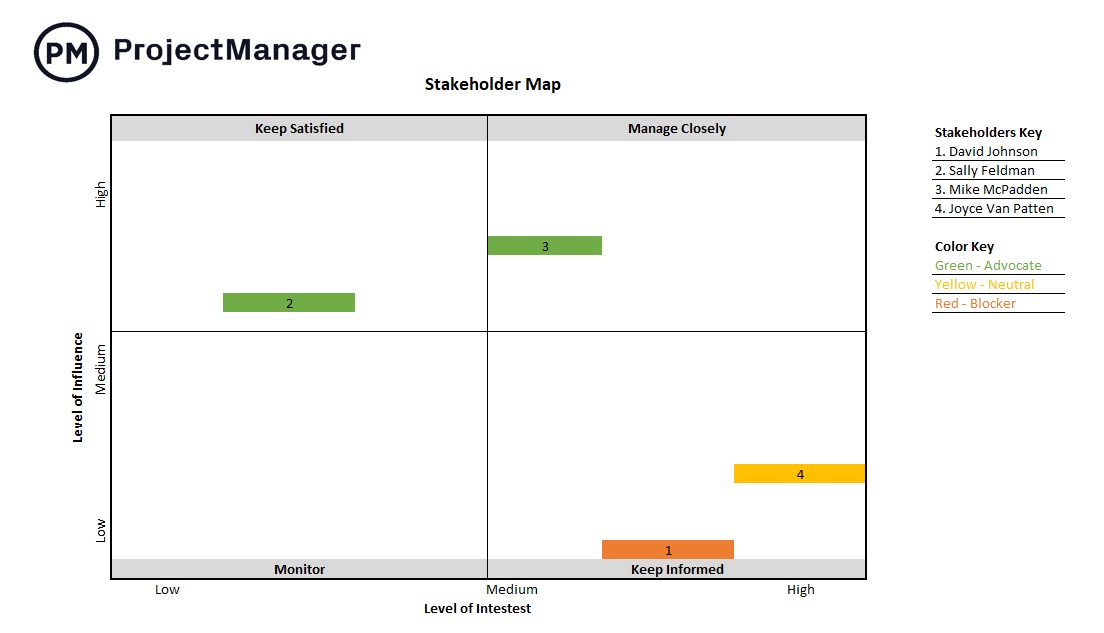
There are four ways to manage your communication with stakeholders based on the power interest matrix: Manage them closely, keep them satisfied, keep them informed or simply monitor them.
- If your stakeholder has a high level of influence in the project but not as much interest, they should be kept satisfied, which means they need regular updates and their feedback is important.
- A stakeholder with both a high level of influence and interest is considered a key stakeholder, whose expectations about the project plan need to be managed closely. That means meeting with them more than the low-influence stakeholder group that is in the “keep satisfied” category, and their feedback is also critical to any decision-making.
- Those who are lower in influence and higher in interest tend to be your customer base. They need updates on progress, too, but not with the frequency of the “manage closely” and “keep satisfied” groups. Those who are low on both influence and interest need project status updates, of course, but probably only need to be informed of big steps in the project.
Stakeholder Map Example
Creating a stakeholder map visualizes the relationship and influence of various stakeholders in a project. Let’s imagine a stakeholder map example for a new manufacturing facility construction project.
For this example, the goal is to build a new manufacturing plant. This involves multiple internal and external stakeholders with different levels of interest and influence. This stakeholder matrix example identifies the key players, their roles and how to manage their expectations.
- Internal stakeholders
- Project management team: This includes the construction manager, engineers and project coordinators. They have the highest level of interest and influence on the project.
- Senior management: These are executives and department heads. They have high influence, but moderate day-to-day interest.
- Operations team: They have moderate influence and high interest as they manage the facility post-construction.
- External stakeholders
- Contractors and construction firms: These stakeholders have high influence and interest as they’re responsible for executing the project.
- Local government and regulatory agencies: They have high interest, but moderate influence as delays in permits can impact the timeline of the project.
- Suppliers: These stakeholders deliver materials and equipment to the job site and have moderate influence and interest in the project.
- Local community: These neighbors have moderate interest and low influence, however, communication with them should remain open to foster goodwill.
- Secondary Stakeholders
- Investors: Those stakeholders funding the project have high influence, but moderate day-to-day interest.
- Environmental agencies: These stakeholders have moderate interest and influence.
Stakeholder maps can take many forms. For this reason we’ve created a blog with multiple stakeholder map examples to further illustrate what a stakeholder map looks like in various scenarios.
Stakeholder Mapping vs. Stakeholder Analysis
Stakeholder mapping is a byproduct of stakeholder analysis. First, you have to do the stakeholder analysis. This begins with brainstorming who your stakeholders are and their level of involvement. You’ll need to figure out their interests and goals.
Once you have done the stakeholder analysis you can begin on stakeholder mapping. The stakeholder map is just a visual for the information gathered during stakeholder analysis. It shows the level of impact and interest for each stakeholder depending on where they land on the map.
Make Reports and Keep Stakeholders Informed with ProjectManager
The stakeholder map helps you understand how and when to communicate with your stakeholders. ProjectManager is award-winning project management software that makes it easy to build reports for stakeholders and keep them in the loop through various project views.
- Use customizable reporting features to show only the data stakeholders will be interested in
- Share reports as PDF attachments or even print them if that’s how your stakeholder prefers
- Free guest licenses allow stakeholders to log in and check progress in real time. Try it free
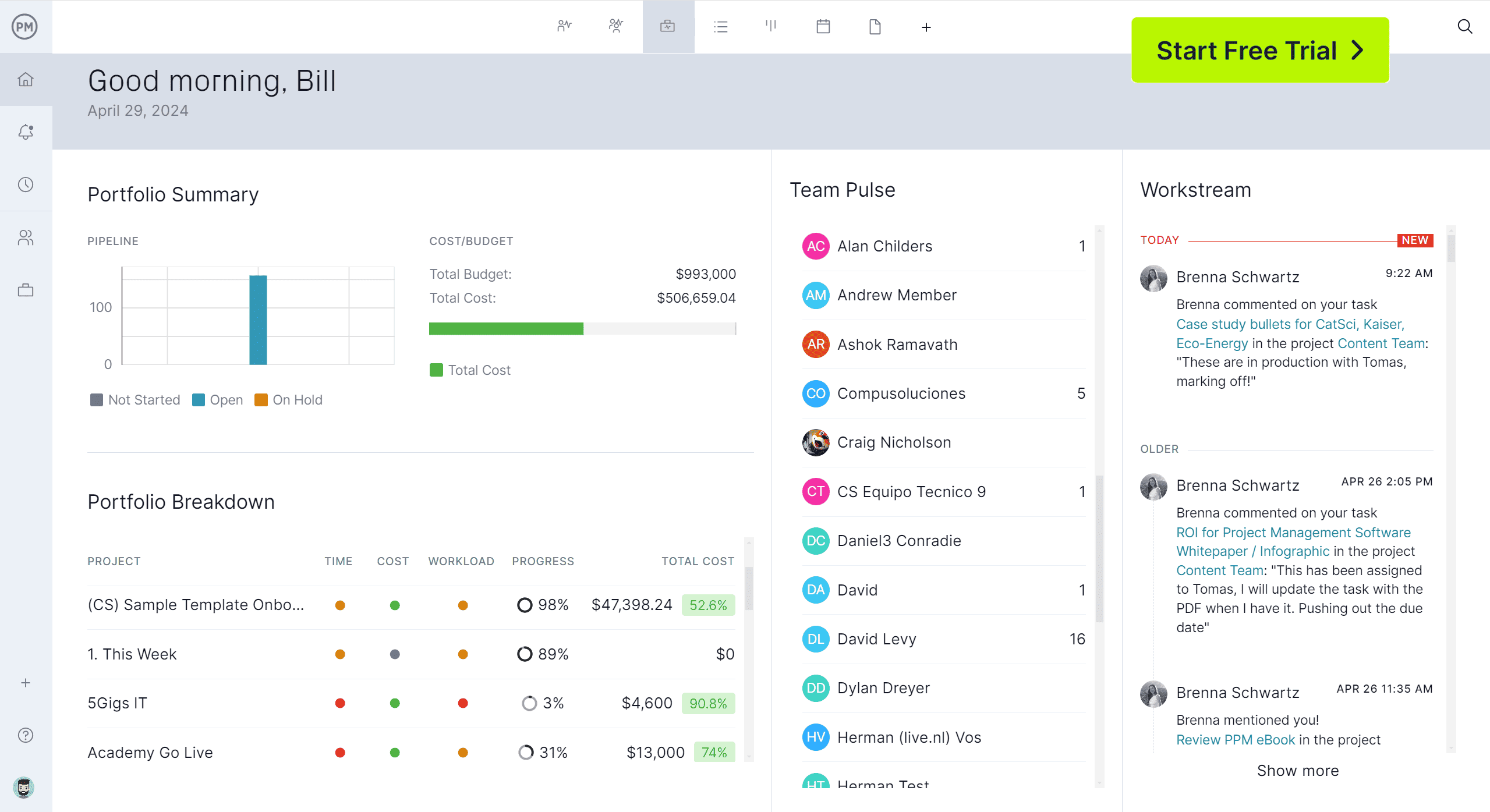
Stakeholder Mapping vs. Stakeholder Engagement
Once you’ve made the stakeholder map you have a guide to stakeholder engagement. Generally, stakeholder engagement is broken up into three types: informing, consulting and collaborating. The placement of the stakeholders when you’ve done the stakeholder mapping process will then inform how you engage with each of these stakeholders.
Stakeholder engagement is how you identify, analyze, plan and implement actions to influence your stakeholders. You determine the needs of your stakeholders and figure out how you’re going to ensure that they’re met. Therefore, the stakeholder mapping process is part of the larger stakeholder engagement process.
Stakeholder Mapping vs. Stakeholder Management
The term stakeholder management refers to the larger process which includes stakeholder mapping, stakeholder analysis and stakeholder engagement. So stakeholder management relates to every decision a project manager makes in regard to their stakeholders, including the frequency of their meetings and how much project management information they are given.
Why Is Stakeholder Mapping Important in Project Management?
Stakeholder mapping is important because stakeholders are important to the success of a project. There are usually two main stakeholder groups, internal and external stakeholders, who have varied expectations. Without mapping stakeholders about their influence and interest in the project, you’re going to have a hard time communicating with them and keeping them happy.
But it’s also a two-way street. Having good communication with stakeholders gives project managers much-needed insight into the project, which helps them in innumerable ways. It helps to mitigate risk and discover the stakeholder’s real goals for the project.
In other words, stakeholder mapping is the start of an effective communication plan between the project team and project stakeholders. Projects cannot succeed if there is little to no communication. The better the communication, the smoother the project will proceed and the easier it will be to understand your stakeholders’ desires.
Stakeholder mapping is also a way to manage expectations. By mapping out your stakeholders, you know how they stand regarding the project. Therefore, as the project is executed, a project manager can incrementally deal with those expectations, bringing them in line with the project so everyone is happy with the deliverables.
What Project Stakeholders Should Be Included In Your Stakeholder Map?
In every project, there are distinct stakeholder groups that will have various levels of power and influence. Here are the most important types of stakeholders you should include in your stakeholder map.
Internal Stakeholders
Internal stakeholders, as we noted above, are those people who are involved in the project. They can be the employees of a company, the project team, managers and even the board of directors. All these people are invested in the success of the project and, in a larger sense, of the company, in one way or another.
External Stakeholders
External stakeholders are not directly involved in the company, but the impact of the project or company will affect them. These can be everyone from suppliers to sponsors and even public groups.
Key Stakeholders
When you’re talking about key stakeholders, you mean those who are the most crucial stakeholders in a project. While all stakeholders are invested in a project, key stakeholders are the most important. They are more invested and more interested in the project’s success than other stakeholders. They can still be employees, customers, investors, et al., but their need for successful project execution is more than other stakeholders.

When Should You Use a Stakeholder Matrix?
A stakeholder matrix is used to review the stakeholders in a project and decide how to determine each in terms of their value to the project. It is used by a project manager to identify the best strategy in dealing with each stakeholder. This work should be done early on in the project, preferably during the project initiation phase. The sooner you can identify and understand how to deal with each of your project stakeholders, the better. Then you’ll have time to develop a strategy for each stakeholder.
But once you have done a stakeholder matrix you’re not done. It is an exercise that you should do regularly throughout the project as stakeholder roles and influence evolve. Then you can update your stakeholder strategy as needed.
How to Create a Stakeholder Map: Stakeholder Mapping Steps
When you’re ready to make your stakeholder map and start the stakeholder mapping process, you’ll want to follow these four steps:
1. Identify Stakeholders
There can be many stakeholders in a project. The list you come up with will depend on your organization, the impact of the project and its objectives. That means you might have to revise the list throughout the project life cycle.
2. Analyze Stakeholders
The next step asks for some stakeholder analysis. This helps you figure out how relevant they are to the project, as well as what perspective they bring. To do this, define what type of stakeholder they are, how much they might contribute to the project and their legitimacy in so doing. Are they willing to engage? How much influence and involvement in the project do they have?
Related: Stakeholder Analysis Template
3. Map Stakeholders
This is when you create your stakeholder matrix and divide it into four, with the y-axis measuring the level of influence from low (bottom) to high (top). On the x-axis, you map the level of interest, low (left) to high (right). Using your list of stakeholders and the analysis you made, plot them according to the two axes.
4. Prioritize Stakeholders
Now that you’ve listed, analyzed and plotted your stakeholders on the map, you can begin to devise a stakeholder engagement strategy on how you’ll engage with the stakeholders throughout the project. Depending on where they land on the map, you will either manage them closely to just monitor them. This is the start of your stakeholder communication plan and overall stakeholder management.
5. Develop Stakeholder Engagement Strategies
Developing stakeholder engagement strategies is important for managing project stakeholders effectively. They must be first identified and then analyzed to assess their influence and interest. These stakeholders can then be categorized and prioritized to develop specific engagement strategies for each group. That can be everything from one-on-one meetings for high influence/high interest to occasional updates for low influence/low interest.
6. Establish a Communication Plan
A communication plan is an essential part of stakeholder mapping in that it ensures effective engagement throughout the project life cycle. To start, review stakeholder analysis and revisit the stakeholder map. Define communication objectives and channels. Then specify frequency and timing. Communication roles should be defined and responsibilities outlined so everyone knows what they’re responsible for.
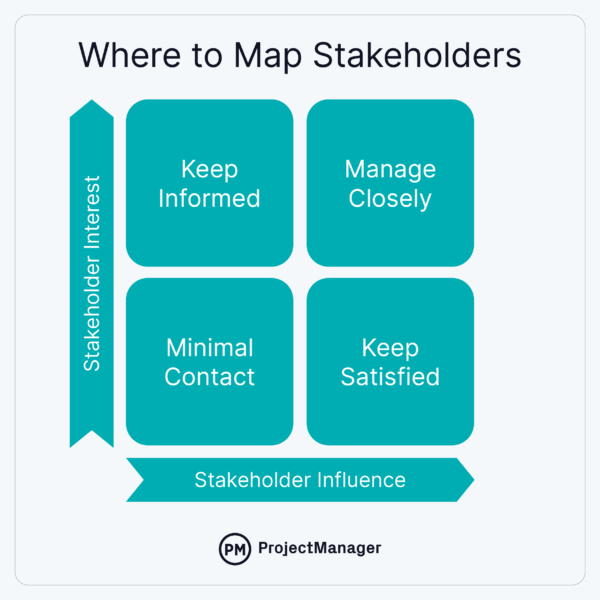
Best Practices When Stakeholder Mapping
It helps if you can get as much information on all your stakeholders as possible. You want to know who they are and how they like to communicate so you can develop a stakeholder engagement strategy. Some might just ask you to text them updates, others want in-person presentations and some might prefer a phone call. Know the method of communication they want and determine a frequency that is right for them.
Be Inclusive
Another aspect of your stakeholder mapping is understanding the cultural or linguistic diversity among them. If they don’t speak your native language, it will require you to adjust your messaging. It’s important to be inclusive and know what is right for one stakeholder might be wrong for another.
Communicate Clearly
The content of your project reports must be clear. You want to avoid jargon and simply present the facts. Be transparent when you’re communicating, and always note what is certain and what is not. Be open to your stakeholders’ feedback and know how they can impact your project management decisions.
Be Open and Honest
Transparency is key for effective stakeholder management, so never hold back on information, especially bad news. The sooner you can get it out in the open, the faster you’ll be able to address stakeholder expectations and manage whatever concerns they might have.
Remain Available
Finally, keep the lines of communication open. Stay in touch with your stakeholders, but also give them a channel by which they can reach you if necessary. When they do, listen to what they have to say, interact with them and ask your own questions. Communication is an exchange of information.
How ProjectManager Helps with Stakeholder Management
While stakeholder maps or power interest grids help with stakeholder analysis, you’ll need other project management tools to engage and manage your stakeholders throughout the project life cycle. ProjectManager is online project management software that fosters real-time communications with reports that capture progress as it happens to help keep everyone involved in the project informed. Our features help you keep your stakeholders updated easily.
Stakeholders want to know how you’re going to deliver the project. Project managers work hard to build a viable schedule on our online Gantt chart, which organizes tasks, manages dependencies and sets milestones. The schedule can be shared with stakeholders to keep them in the loop.
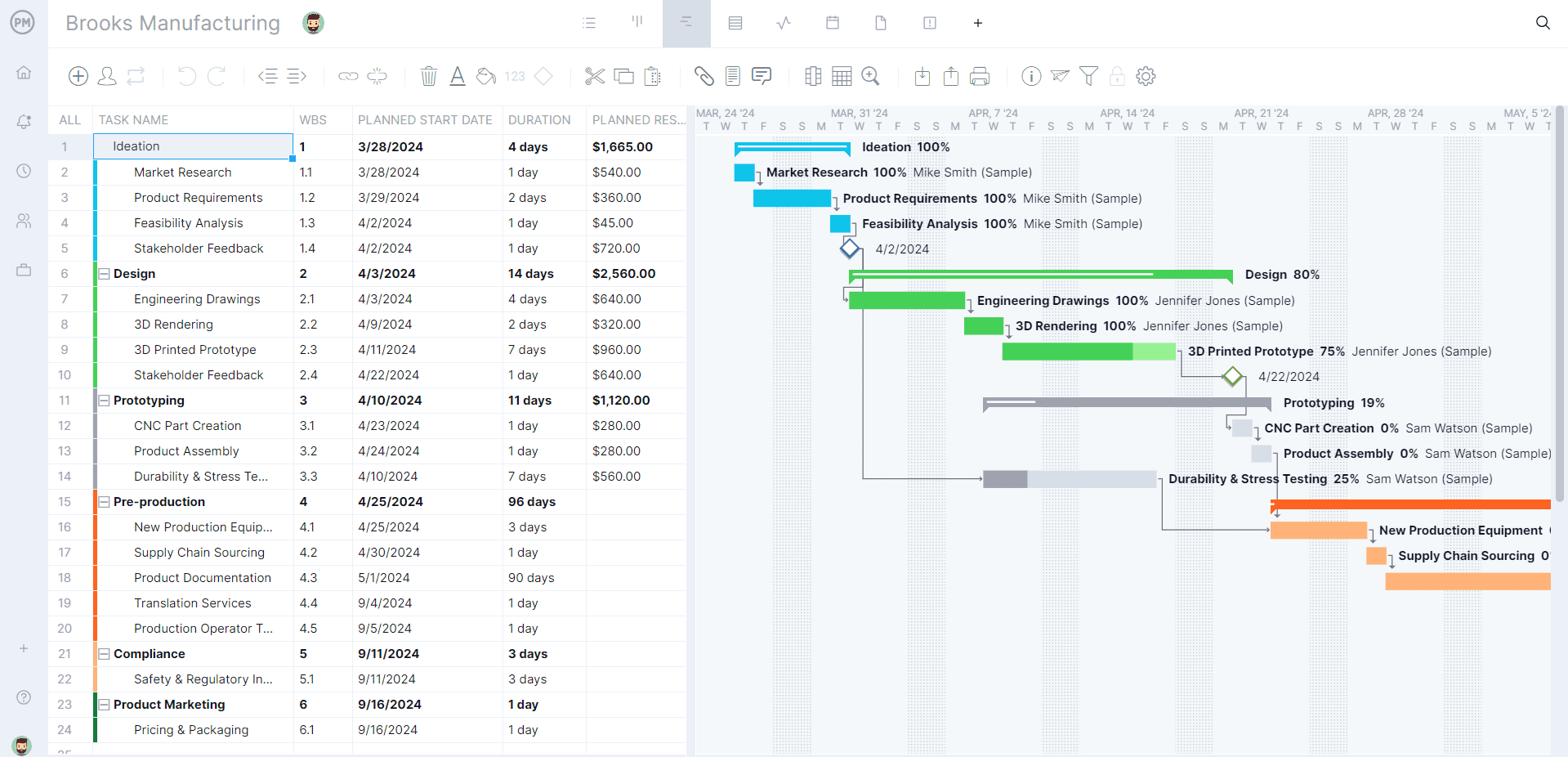
Provide Stakeholders with Real-time Data
Once they know your plan, they’re going to want to see how it is progressing during execution. You can share the real-time dashboard, which shows a high-level view of project metrics such as progress on tasks, time left on work, costs and more.
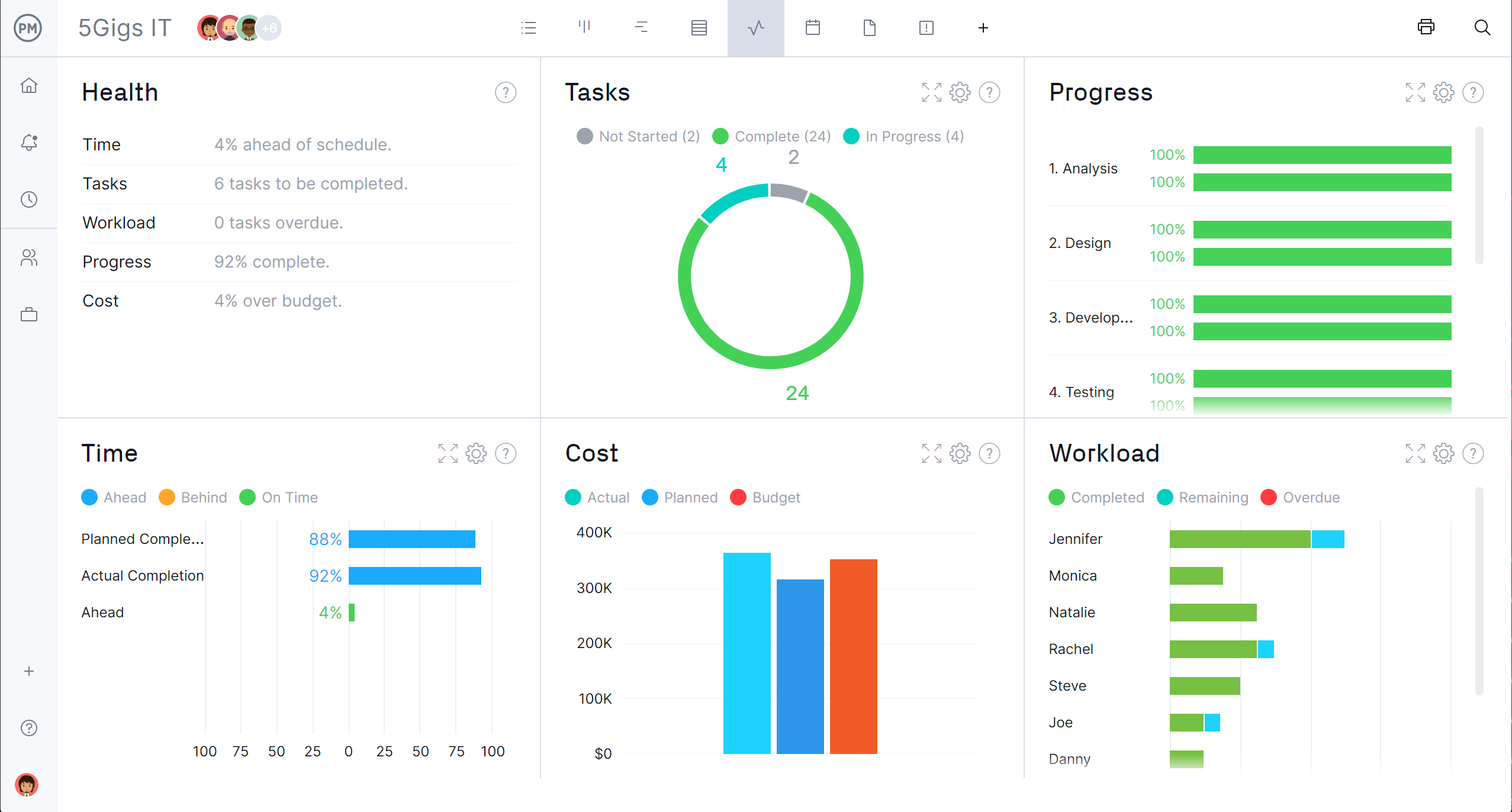
Give Stakeholders Project Details When Required
For a more in-depth look at progress and performance, we have one-click reporting. Generate status reports, project costs and much more with just a keystroke. Then print or share the report with stakeholders, and all project management reports can be filtered to show just the data they’re interested in.
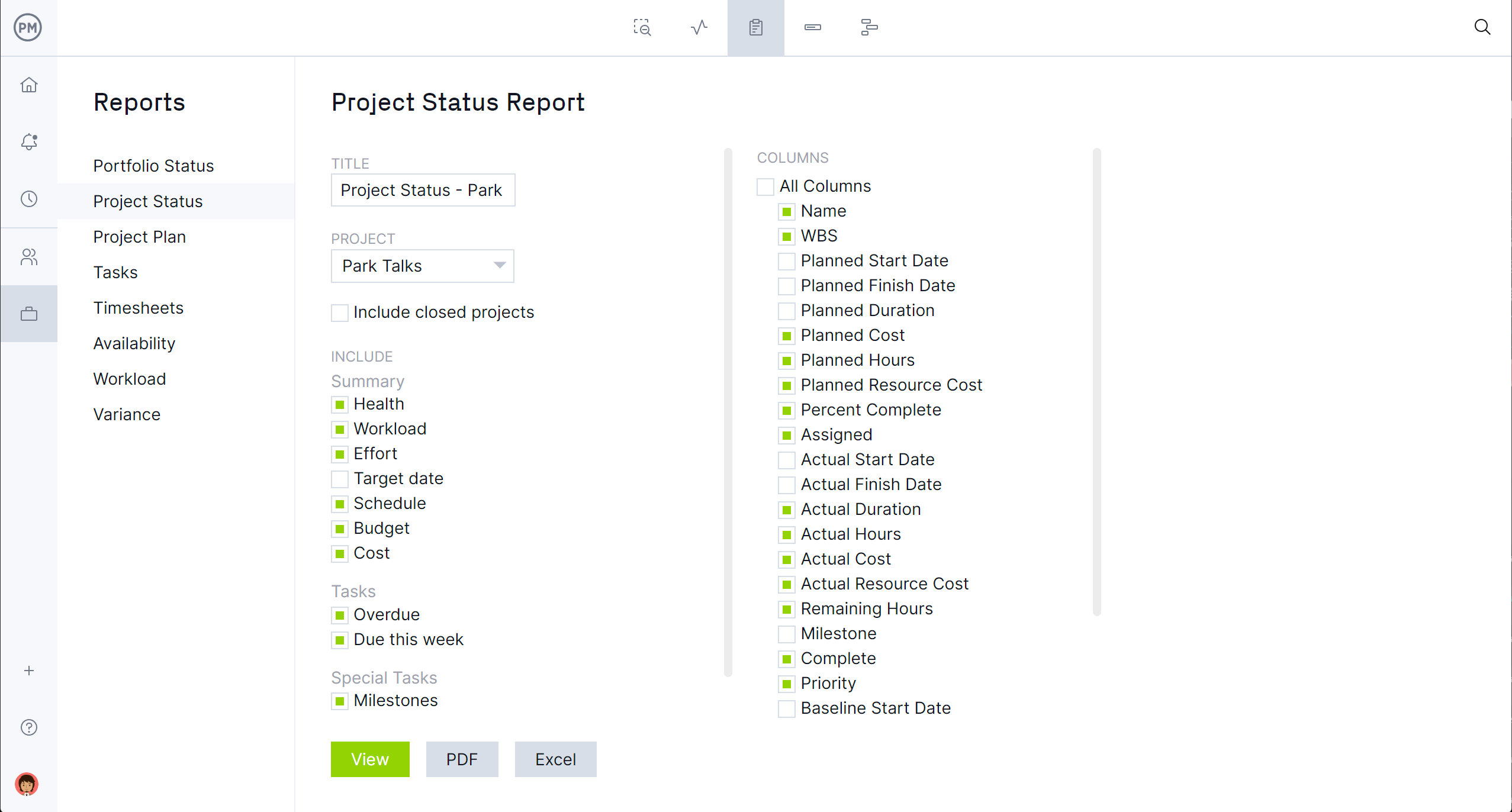
ProjectManager is an award-winning tool that organizes tasks, teams and stakeholders. You get features to keep teams collaborating and their workload balanced for greater productivity. Stakeholders can instantly see their progress and stay informed at a high level or with greater detail. Satisfy your stakeholders by planning, monitoring and reporting better today by taking this free 30-day trial.


